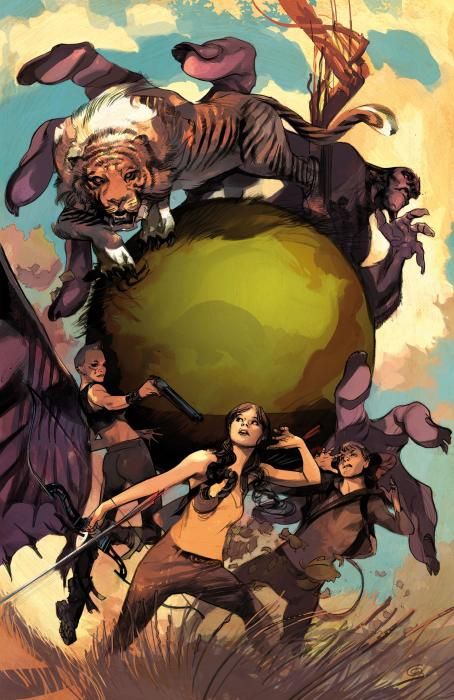Ian Edginton and Francesco Trifogli begin "Hinterkind" #1 with a cinematic teaser page, zeroing with fractured camera closeups on a scene of bloody mayhem and some monstrous hands, before cutting away into the splendor of a forest landscape. It's a great introduction, because the two settings together sum up the vivid energy and man vs. nature themes of the title.
There's a lot of world-building to do with a post-apocalyptic civilization, and thankfully, Edginton reveals a lot of the world without information dumps. First, Edginton uses the technique of a fictitious historical or religious text, in this case, the casual voice of "The First Book of Monday," to set up backstory and also to give this world a sense of history. Secondly, he reveals the world through following two young characters who draw the reader in through their dialogue and friendship.
With so much focus on the new world order, Edginton doesn't have a lot of room to develop characterization. Prosper's wise and protective mentor-figure father is definitely a type, but Edginton's dialogue gives Prosper and Angus's friendship some depth and spark. It does feel too convenient for the plot that the two would find a reason to ditch the adults and take off. The catalyst for this action is Angus' secret, an unexpected twist. Another notable part of Angus' identity is also revealed by the pictures on his wall, but Trifogli's panel transitions cleverly downplay one set of facts to maximize the reader's and Prosper's shock.
Edginton also lulls the reader by playing up the camaraderie and affection between the human characters, so the violence of the first page is almost forgotten by the time the plot decides to remind the reader that this world has other threats. The profanity in the scene when this other threat is introduced is effective in reinforcing the jolt to the reader's complacency. The villains aren't given enough panel time for character development, but Edginton drops in an enticing hint about an impatient and violent queen.
Francesco Trifogli's is art is an excellent match for the rapid world-building. Instead of the usual motion lines, he draws an action scene of Prosper hunting by showing the faded trace of her old position. It's a well-executed image, and feels appropriate to the landscape of foliage-created shadows and sunshine.
In the introductory sequence for Prosper and Angus, Trifogli's camera angle pulls away to reveal their home settlement in a beautiful, almost abstract landscape, emphasizing the smallness of the red and brown bits of civilization almost lost within the dominant green. Cris Peter's palette evokes the wildness and brilliancy of the verdant world. The colors are attention-grabbing and reinforce Edginton's intention that nature itself is a character in "Hinterkind" #1.
"Hinterkind" #1 is a strong expository issue, establishing the main characters, central themes and conflicts. It skimps on characterization in favor of action and world-building, but there is still enough to hook readers into picking up the next issue.

